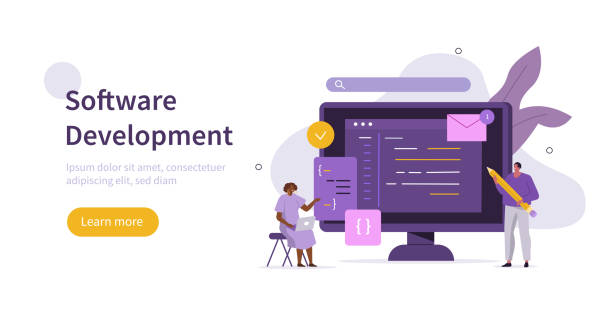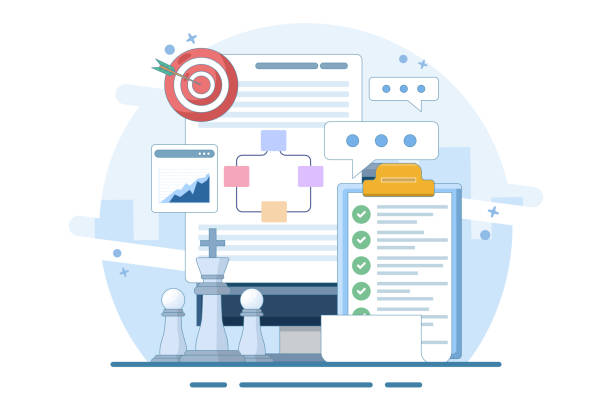Introduction to Secure Website Design and its Importance

In today’s world, where all aspects of our lives depend on the internet, secure website design is no longer an option, but an undeniable necessity.
Websites, from online stores to news and educational platforms, are the storage and exchange points for sensitive information of millions of users.
Imagine a banking website or an online health service whose customer information has been stolen by cyber attackers; the consequences of such an event can be catastrophic.
The importance of #cybersecurity and #data_protection in the online space has become more prominent than ever.
Secure website design means implementing measures and protocols that protect the website against various cyber attacks.
These measures include using secure coding techniques, proper server configuration, data encryption, and user access management.
The ultimate goal is to ensure the confidentiality, integrity, and availability of data and information.
In this educational and explanatory article, we comprehensively examine various aspects of web security and how to achieve a robust website.
An insecure website can quickly damage your credibility and reputation, leading to customer loss, heavy legal penalties, and even business collapse.
Users’ personal data, financial information, and even intellectual property are all at risk.
Any security breach not only harms public trust but can also incur significant costs for recovery and damage repair.
Therefore, investing in secure website design is, in fact, an investment in the future of your business and the preservation of your informational assets.
This specialized approach not only protects your information but also gains user trust and ensures the stability of your online business.
Web security must be considered from the very beginning of the development process (Security by Design), rather than being added as a separate section or an add-on at the end.
Did you know that 94% of users’ first impressions of a business are related to its website design? With professional corporate website design by **Rasawweb**, turn this first impression into an opportunity for growth.
✅ Attract more customers and increase sales
✅ Build credibility and trust in the audience’s view⚡ Get free website design consultation!
Common Web Vulnerabilities and Ways to Counter Them

To have a secure website design, we must first become familiar with the most common vulnerabilities that threaten websites.
Identifying these weaknesses is the first step towards #prevention and #cyber_defense.
One of the most well-known attacks is SQL Injection, where an attacker injects malicious SQL code into program inputs (such as search or login forms) to gain access to the database and manipulate or steal information.
This attack can lead to the disclosure of sensitive information, data alteration, or even complete deletion of the database.
Another is Cross-Site Scripting (XSS) attacks, where malicious scripts are injected into web pages and executed in the victim’s browser.
These scripts can steal user cookies and session information, disclose personal data, or even alter the website’s appearance to deceive the user.
Cross-Site Request Forgery (CSRF) attacks are also serious threats where an attacker deceives an authenticated user into performing unwanted requests without their knowledge, such as changing a password or transferring funds.
Vulnerabilities related to #session_management, incorrect server configurations, and weak access management (Broken Access Control) are also common.
For example, if the access system is not properly configured, an ordinary user might be able to access administrative pages or other users’ information.
To counter these threats, an analytical and specialized approach is needed.
For instance, to prevent SQL Injection, Prepared Statements or ORMs should be used, and all user inputs must be carefully validated.
For XSS, all user inputs must be properly filtered and encoded before being displayed on the page.
Against CSRF, the use of anti-CSRF tokens in forms is essential.
This explanatory and specialized section emphasizes that secure website design requires a deep understanding of these vulnerabilities and continuous implementation of best security practices.
Principles of Secure Coding and Prevention Strategies

Secure website design fundamentally begins with #secure_coding.
Developers play a crucial role in creating a secure online environment.
Many vulnerabilities arise from common coding mistakes, which can be prevented by adhering to specific principles and standards.
One of the most important principles is #input_validation.
All data received from the user must be carefully validated and sanitized to prevent the injection of malicious code.
This includes checking data type, length, format, and permissible range.
Also, the use of secure functions and libraries is recommended; instead of writing encryption or validation functions from scratch, it is better to use reputable and tested libraries, as these libraries have been reviewed and strengthened by the security community.
Another principle is proper error and exception handling.
Sensitive information should not be disclosed in error messages, as this information can be exploited by attackers to identify system weaknesses.
All error information should be logged internally, and only generic, non-sensitive messages should be displayed to the user.
Regularly updating used libraries and frameworks is also very important, as older versions may contain known vulnerabilities that attackers are aware of.
Using strong #hashing for passwords instead of storing them as plain text is another vital point, and strong algorithms like bcrypt or Argon2 should be used.
Secure website design also includes adhering to the Principle of Least Privilege; meaning every user, process, or module should only have the minimum necessary permissions to perform its tasks.
This approach helps minimize damage even if a part of the system is compromised.
#Secure_Session_Management is also of high importance; sessions should have unpredictable and expiring tokens and should terminate after a specific period of inactivity or user logout.
This specialized section emphasizes the importance of continuous developer training and adherence to security checklists throughout the software development life cycle.
| Validation Type | Description | Example Usage |
|---|---|---|
| Data Type Validation | Ensuring that the input is of the expected data type (e.g., number, string, date). | Age (integer only), Date of Birth (valid date format) |
| Length Validation | Controlling the minimum and maximum input length to prevent buffer overflow attacks. | Password (at least 8 characters), Username (maximum 20 characters) |
| Format Validation (Regex) | Checking if the input matches a specific pattern (e.g., email, phone number, national ID). | Email address (example@domain.com), Mobile number (0912xxxxxxx) |
| Range/Domain Validation | Ensuring that the input falls within an allowed domain or range. | Survey rating (between 1 and 5), Product quantity (minimum 1) |
| Sanitization | Removing or encoding special characters that can lead to attacks (e.g., XSS). | Converting < > to < > in text inputs |
The Importance of SSL/TLS Certificates in Data Protection

One of the main pillars of secure website design is the use of SSL/TLS certificates.
These certificates convert the HTTP protocol to HTTPS and create a layer of #data_encryption between the user’s browser and the website server.
This process, known as the “SSL/TLS handshake”, involves the exchange of encryption keys and server identity verification, ensuring that you are indeed connected to your intended website and not a phishing site.
When information such as usernames, passwords, or credit card details are transmitted via a website with HTTPS, this information is encrypted and hidden from attackers.
This ensures that even if information is intercepted along the way, the attacker cannot access or misuse its content.
Aside from security, using HTTPS has other benefits.
Search engines like Google prefer websites with HTTPS in their search rankings.
This means that secure website design with SSL/TLS can help improve your #SEO and website visibility.
Also, modern browsers mark websites without HTTPS as “not secure”, which can lead to a decrease in user trust and loss of visitors.
The “Not Secure” message in the browser’s address bar quickly deters users from visiting your website.
There are different types of SSL/TLS certificates, including Domain Validation (DV), Organization Validation (OV), and Extended Validation (EV).
A DV certificate only verifies domain ownership and is the fastest and cheapest type.
OV, in addition to the domain, also verifies the issuing organization.
Finally, EV certificates provide the highest level of trust and display the organization’s name in the browser’s address bar (green bar).
Each offers a different level of authentication.
Choosing the appropriate certificate type depends on the type of business and the level of sensitivity your website deals with.
This educational and explanatory section emphasizes the importance of certificates as a fundamental guide in the secure website design process, ensuring that user communications are fully protected.
Did you know your company’s website is the first point of contact for 75% of potential customers?
Your website is the face of your brand. With **Rasawweb**’s corporate website design services, build an online presence that earns customer trust.
✅ Create a professional and lasting image for your brand
✅ Attract target customers and increase online credibility
⚡ Get free consultation from **Rasawweb** experts!
Server Security and Its Proper Configuration

Secure website design is not limited to coding and protocols; server infrastructure security is also of high importance.
The server hosts your website, and if not properly configured and protected, it can become a major weakness.
The first step in #server_security is choosing a reputable and reliable hosting provider that adheres to security principles and properly protects its physical and virtual infrastructures.
Installing and configuring a Firewall is one of the fundamental measures.
Firewalls control incoming and outgoing server traffic and can prevent unauthorized access and external attacks.
This includes configuring firewall rules to allow only essential traffic (such as port 80 for HTTP and 443 for HTTPS) and blocking the rest.
Using #Intrusion_Detection_Systems (IDS) and #Intrusion_Prevention_Systems (IPS) can also help detect and block attacks in real-time.
Regularly updating the server’s operating system, web server software (such as Apache or Nginx), and other applications is also crucial.
Many attacks occur through exploiting known vulnerabilities (CVEs) in outdated and unpatched software.
The principle of least privilege should also be observed at the server level; user accounts with root or admin access should be restricted and only used when necessary and with extreme caution.
Additionally, disabling unnecessary services on the server can reduce the attack surface and eliminate potential weaknesses.
Continuously monitoring server logs (such as access logs, error logs) to identify suspicious activities, intrusion attempts, and unusual patterns is also an important step.
This guiding and specialized section emphasizes that without a secure server infrastructure, even the best secure website design might be compromised, and all your security efforts will be futile.
Database Security Measures and Protection of Sensitive Information

The database is the heart of any website, containing valuable and sensitive user information.
Therefore, #database_security is an inseparable component of secure website design.
The first and most important step is #data_encryption.
Sensitive information such as passwords (which should be hashed and not merely encrypted), credit card numbers, and users’ personal information must be encrypted both during transmission (with SSL/TLS as explained in the previous section) and at rest (Encryption at Rest).
This ensures that even if an attacker gains access to the database, they will find the information encrypted and unusable.
Applying the principle of Least Privilege for database user accounts is also vital.
Each user or application should only have access to the minimum data and operations required for their tasks.
For example, a website user should not be able to access other users’ information unless such access is specifically defined for them.
This includes restricting access to specific tables, columns, and even operations (such as reading, writing, deleting).
Separating the database from the web server in a separate, firewall-protected network adds another layer of security and prevents direct access to the database.
Regular and automatic backups of the database and ensuring the integrity and security of these backups are also very important.
These backups should be stored in a secure, off-site location and have quick recovery capabilities.
In the event of any cyber attack or system failure, a secure backup can quickly restore the website to normal operation.
Monitoring database activities to identify unusual access patterns, intrusion attempts, and suspicious changes is also essential.
This specialized and educational section emphasizes the importance of comprehensive data protection at all stages, because without a secure database, the concept of secure website design will be incomplete and can lead to the loss of vital information and user trust.
User Authentication and Authorization: A Vital Role in Secure Website Design

User #authentication and #authorization systems are the main gateways to any website and therefore play a vital role in secure website design.
Ensuring that only authorized users have access to specific information and functionalities is a cornerstone of security.
The use of strong and unique passwords for users should be encouraged and even enforced.
This means mandating the use of a combination of uppercase and lowercase letters, numbers, and symbols, as well as an appropriate password length (at least 12-16 characters).
Also, storing passwords as plain text in the database should be avoided, and strong and appropriate hashing algorithms (such as bcrypt or PBKDF2) should be used.
#Multi-Factor_Authentication (MFA) adds a powerful security layer to the login process.
MFA requires the user to provide a second factor (such as a code sent to a mobile phone via SMS or Authenticator apps, a fingerprint, or a hardware token) in addition to the password.
This method makes unauthorized access extremely difficult even if the password is compromised and is strongly recommended for any website that manages sensitive information.
User session management is also of high importance.
Sessions should expire after a specified period of inactivity to prevent session hijacking attacks.
Additionally, secure and unpredictable tokens should be used for session management, which are regularly regenerated and store sensitive information such as the user’s IP address.
Authorization systems must also be properly implemented to ensure that each user only has access to resources defined for their role.
This means implementing strict access controls on the server-side, not just on the client-side (as client-side controls can be bypassed).
This specialized and guiding section emphasizes the importance of correctly selecting and implementing these mechanisms to ensure a comprehensive and secure website design.
Proper implementation of these principles assures users that their information is safe, which is vital for any online business and can play a key role in gaining customer trust.
| Security Method | Description | Benefits for Secure Website Design |
|---|---|---|
| Strong Password | Enforcing the use of a combination of uppercase/lowercase letters, numbers, symbols, and appropriate length (minimum 12 characters). | Reduces the risk of guessing and dictionary attacks and increases resistance to Brute Force attacks. |
| Multi-Factor Authentication (MFA) | Requiring a second factor (e.g., SMS code, authenticator app, or biometrics) in addition to the password. | Significantly increases security even if the primary password is compromised, by adding another layer. |
| Secure Session Management | Expiring sessions after inactivity, using secure tokens, and regenerating tokens on each login. | Prevents Session Hijacking attacks and ensures the security of active sessions. |
| Login Attempt Limits | Locking the account after multiple failed login attempts within a specified timeframe. | Effectively counters Brute Force attacks and protects user accounts. |
| Role-Based Access Control (RBAC) | Granting user access based on predefined roles in the system. | Implements the principle of least privilege and prevents unauthorized access to sensitive resources. |
Periodic Security Audits and Penetration Testing

Even the best secure website design cannot remain completely secure without continuous monitoring and testing.
The world of #cyber_threats is constantly evolving, and new vulnerabilities are discovered daily.
For this reason, conducting periodic security audits and Penetration Testing is of high importance.
These proactive and reactive approaches help organizations stay one step ahead of attackers and fix weaknesses before they are discovered by malicious individuals.
#Security_auditing involves a comprehensive review of source code, server configurations, and security protocols to identify weaknesses.
This process can be conducted by an internal team using automated and manual tools, or with the help of external security experts (auditors).
The primary goal is to identify vulnerabilities that might have been overlooked during the development process or introduced after new system updates and changes.
Code audits can reveal logical errors and weaknesses that automated tools might not detect.
Penetration testing is a controlled simulation of a real cyber attack performed by security professionals (ethical hackers).
These tests involve various stages, including reconnaissance, vulnerability scanning, exploitation of weaknesses, and persistence.
The results of penetration testing provide a comprehensive report of discovered vulnerabilities and practical recommendations for remediation.
Penetration tests can be either Black-Box (without knowledge of the internal system structure) or White-Box (with full access to code and infrastructure).
This analytical and informative approach not only helps strengthen secure website design but also keeps organizations aware of the latest threats and attack methods.
Regularly conducting these tests is an essential part of a comprehensive cybersecurity strategy for any website, demonstrating how committed the organization is to protecting its users’ data and actively defending against threats.
Does your current website build the trust that potential customers should have in your business? If the answer is no, it’s time to have your professional and impactful corporate website with Rasawweb.
✅ Fully customized design tailored to your brand identity
✅ Increased lead generation and business credibility in the eyes of customers⚡ Contact us for a free consultation!
Incident Response and Disaster Recovery: Planning for the Worst-Case Scenario

Regardless of the investment in secure website design, no system is 100% impenetrable.
Cyber threats are constantly evolving, and even the most advanced defenses may eventually face challenges.
Therefore, having a well-structured and effective plan for #Incident_Response and #Disaster_Recovery is crucial.
These plans help organizations react quickly and effectively in the event of a cyber attack or system failure, preventing more serious damage, which includes reducing service downtime and minimizing financial and reputational losses.
The incident response plan should include specific steps for identifying, containing, eradicating, and recovering from a security incident.
This includes defining the responsible team (e.g., CSIRT – Computer Security Incident Response Team), emergency communication channels, and reporting protocols to regulatory bodies and users.
For example, upon detecting a breach, the attacker’s access should be immediately blocked, the source of the intrusion identified and mitigated, all affected systems cleaned, and then systems restored to a secure state.
Timely and transparent notification to users and relevant authorities about data breaches is also often a legal and ethical requirement.
The disaster recovery plan focuses on restoring systems and data after a natural disaster (such as natural calamities) or a devastating cyber attack (such as widespread ransomware attacks).
This includes having regular, encrypted, and off-site backups, as well as the ability to quickly and efficiently restore systems from these backups.
#Backup_testing and recovery plans should be performed regularly to ensure their reliability and to keep Recovery Time Objective (RTO) and Recovery Point Objective (RPO) within acceptable limits.
This guiding and specialized section emphasizes that preparedness for the worst-case scenario is a critical element in a sustainable and responsible secure website design and can make the difference between a temporary disruption and a business catastrophe.
This preparedness ensures that even against unexpected threats, your online business is able to quickly return to normal operations.
The Future of Web Security and Continuous Improvement in Secure Website Design

The world of cybersecurity is dynamic and constantly changing.
Attackers are continually discovering new methods of intrusion, and new technologies bring emerging threats.
Therefore, #secure_website_design is not a one-time process, but a continuous and evolutionary effort.
Websites must be continuously monitored, and their security measures updated as new threats emerge to always remain resistant to the latest threats.
This approach means adopting a security culture that permeates all operational and developmental aspects of an organization.
Future trends in web security include the increasing use of Artificial Intelligence (AI) and Machine Learning for detecting and preventing more advanced attacks, such as sophisticated #Phishing attacks, targeted #Malware, and Zero-Day attacks.
These technologies are capable of analyzing vast amounts of data and identifying unusual patterns that humans might not notice.
Also, API (Application Programming Interfaces) security will become more important, as websites increasingly rely on external APIs, and these connection points can be gateways for intrusion.
#Cloud_Security will also become a critical area as more businesses migrate to the cloud, requiring its own specific security approaches.
Promoting security culture and continuous education for users and developers will also play a key role in the future of secure website design.
Awareness of risks, understanding social engineering attacks, and adhering to best practices in usage and development minimize human error, which is often the primary cause of many security breaches.
The challenging content in this area is whether we can always stay one step ahead of attackers? The answer to this question requires continuous investment in research and development, international cooperation for threat intelligence sharing, and adopting a mindset of continuous improvement.
This analytical section shows that a commitment to continuous improvement is essential not only for maintaining secure website design but also for survival and growth in an increasingly complex digital ecosystem, and without it, no website can claim complete security.
Frequently Asked Questions
| No. | Question | Answer |
|---|---|---|
| 1 | What does secure website design mean? | Secure website design refers to a set of measures and methods used to protect a website against cyber attacks, unauthorized access, data leaks, and other security threats. Its goal is to maintain the confidentiality, integrity, and availability of information. |
| 2 | Why is website security important? | Website security is crucial for maintaining user trust, protecting sensitive information (such as personal and financial data), preventing financial losses, preserving brand reputation, and complying with legal regulations (such as GDPR). A security breach can lead to customer loss and heavy penalties. |
| 3 | What are some of the most common security attacks against websites? | Common attacks include SQL Injection, XSS (Cross-Site Scripting), CSRF (Cross-Site Request Forgery), Brute Force, DDoS attacks, Broken Authentication, and Missing Function Level Access Control. |
| 4 | What is the role of an SSL/TLS certificate in website security? | An SSL/TLS certificate (which leads to an HTTPS address) is used to encrypt data exchanged between the user and the website server. This prevents eavesdropping or manipulation of sensitive information like passwords and credit card details during transmission and verifies the website’s authenticity. |
| 5 | How can SQL Injection attacks be prevented? | To prevent SQL Injection, Prepared Statements or ORM (Object-Relational Mapping) with validated parameters should be used. Also, careful filtering and validation of user inputs (Input Validation) and applying the principle of least privilege in the database are essential. |
| 6 | What is HTTP Strict Transport Security (HSTS) and how does it help security? | HSTS is a web security policy that tells browsers to load the website only via an HTTPS connection, even if the user enters the address with HTTP. This prevents Downgrade attacks and cookie hijacking on public Wi-Fi networks. |
| 7 | What is the importance of regular software and plugin updates in website security? | Regularly updating the Content Management System (CMS), plugins, themes, and other software components of the site is crucial for patching discovered security vulnerabilities. Developers constantly release security patches, and failing to update can leave the site vulnerable to known attacks. |
| 8 | What measures can be taken to increase the security of the website’s administration section (admin panel)? | Changing the default admin panel path, using strong passwords and two-factor authentication (2FA), restricting access to specific IPs, using CAPTCHA on login pages, monitoring logs, and continuous CMS updates are among these measures. |
| 9 | Why is filtering and validating user inputs (Input Validation) important? | Filtering and validating inputs helps prevent the injection of malicious code or unauthorized data through forms, URLs, or other user input sections. This prevents attacks like XSS and SQL Injection that exploit invalid inputs. |
| 10 | Name some common tools or services for checking and enhancing website security. | Tools such as Web Application Firewall (WAF), vulnerability scanners (e.g., Acunetix, Nessus), Intrusion Detection and Prevention Systems (IDS/IPS), CDN services with security features (e.g., Cloudflare), and periodic Penetration Testing can enhance website security. |
And other services of Rasawweb Advertising Agency in the field of advertising
Smart Sales Automation: Revolutionize digital branding with attractive UI design.
Smart Digital Advertising: An effective tool for campaign management with the help of key page optimization.
Smart Marketplace: A professional solution for digital branding with a focus on intelligent data analysis.
Smart Data Analysis: A combination of creativity and technology for digital branding through custom programming.
Smart Marketing Automation: An effective tool for improving SEO ranking with the help of precise audience targeting.
And over hundreds of other services in the field of internet advertising, advertising consulting, and organizational solutions
Internet Advertising | Advertising Strategy | Advertorial
Resources
Website Security PrinciplesSSL Certificate and Its ImportanceData Protection in the Online SpaceBest Practices for Secure Design
? With Rasawweb Afarin, revolutionize your business in the digital world! From professional WordPress website design to powerful SEO and social media management, we are with you to shine at your peak.
📍 Tehran, Mirdamad Street, next to Bank Markazi, Kazeroun Jonoubi Alley, Ramin Alley, No. 6




